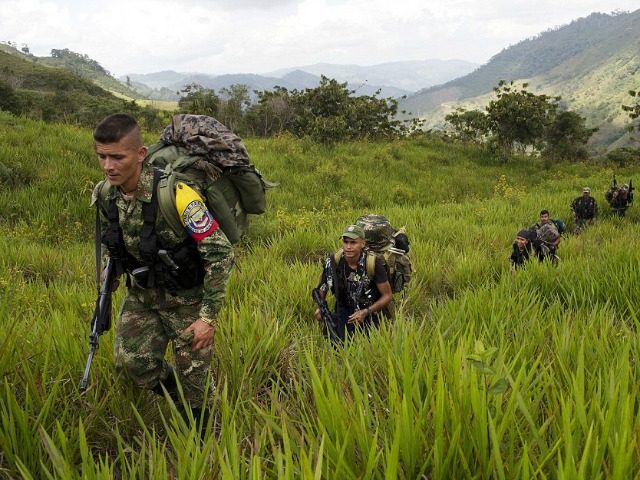A Colombian soldier who participated in the 2003 looting of buried savings hidden by the FARC terrorist group has been captured, and is pleading to be placed in a prison with women, as he used some of the money stolen from the crime scene for a sex change.
On April 14, 2003, a group of 147 Colombian soldiers found eighteen buried stashes of Colombian pesos and U.S. dollars totaling 40 million pesos (about $14,000). Rather than report the money as evidence against the terrorist group they were investigating, the Revolutionary Armed Forces of Colombia (FARC), they split the money among themselves and fled. In 2007, Colombia’s attorney general issued an official order to strip the remaining fugitive soldiers of their titles in the military and ban them from any public office for at least six years.
The Attorney General’s office said in a 2007 statement condemning the theft:
Deposits in which illegal armed groups stock and hide war materials, funds, rations, documents, valuables or any other element necessary to their illicit activity are not stray or lost goods, or treasures to be acquired by discovery. They have origins against the law which force Armed Forces servicemen to inform their superiors of its existence and put them at the disposition of the judiciary.
To this day, the Colombian government has only been able to retrieve less than $700 from that finding of hidden FARC money. Colombian newspaper El Tiempo notes that some involved in the theft have been “killed, tortured, and kidnapped” as the FARC has tried to retrieve its funds.
Bonilla is the last of the soldiers involved in the finding to be arrested, caught on April 15, 2016, after being routinely asked to show his identification in the city of Cali.
Bonilla is from Caquetá, the region where the money was initially found. He told police he had been traveling around the country for the last thirteen years, working on transitioning into a woman. He identifies as transgender, he claims, and was not trying to change his gender to avoid police. When he was arrested, however, he was wearing men’s clothes and appeared as a cisgendered male. Multiple reports confirm that Bonilla told authorities he had undergone surgery to transition into a woman, which he had apparently paid for with FARC money.
The other soldiers arrested in relation to this mass theft were initially sentenced to ten years in prison, but have since had their sentences reduced to four years and three months.
The bizarre story returns the debate over how wealthy the FARC terrorist group is to Colombia’s national spotlight. In 2014, Forbes estimated that the group generates $600 million a year selling cocaine, demanding ransoms for kidnapping victims, and working with other terrorist groups and friendly governments in the region, like those of Venezuela and Cuba. The sum makes the FARC the world’s wealthiest non-jihadist terrorist group and the third-wealthiest when taking the Islamic State and Hamas into account.
In April, The Economist published a report suggesting the FARC have amassed about $10.5 billion in total assets in 2012, citing “an unpublished study by government analysts” for the number. Evidence suggests that the FARC have hidden the money well inside Colombia’s infrastructure, investing in anything from transport to stocks, and keeping international intelligence organizations from finding the money.
FARC terrorists – currently embroiled in “peace talks” with the government of Juan Manuel Santos – are desperately trying to depict themselves as destitute to avoid paying damages to the victims of murders, kidnappings, rapes, forced abortions, and other illicit activities. “What a joke that Economist story. They should check their sources and not believe stories about the insurgency’s imaginary fortune,” Iván Márquez, the FARC’s chief peace negotiator, tweeted in response to the story. Márquez and other FARC leaders have repeatedly denied that the FARC has the money to pay the victims of terrorist activities they orchestrated.
Márquez and the head of the terrorist group, “Timochenko,” have been living openly in Havana, Cuba, since 2012. FARC leaders marched in Cuba’s Marxist Workers’ Day parade on Sunday, waving Cuban flags and wearing red. They also met with U.S. Secretary of State John Kerry in March during President Barack Obama’s trip to the island. Despite Cuba’s open support for the FARC, President Obama removed the nation from the State Department’s State Sponsors of Terrorism list last year.
In Colombia, peace talks with the FARC remain extremely unpopular, as the government failed to meet a March 23 deadline to agree on specific terms of the peace deal. In April, an estimated 250,000 Colombians marched in opposition to further peace talks with the group.

COMMENTS
Please let us know if you're having issues with commenting.